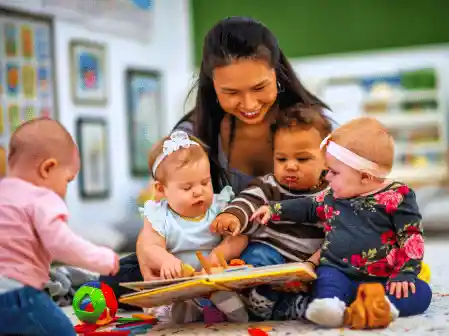Infants & Toddlers Routines & Environments

Planning for Joy: Environments, Rituals and Routines to Support Responsive Caregiving for Infants, Toddlers and Twos
The concept of “Back to School” doesn’t always apply to early child professionals that work with our youngest children. Transitions to new classrooms and teachers for infants, toddlers and twos are less likely to align with our “school calendar” and are more often based on children’s age and developmental milestones. Perhaps your setting includes multi-age rooms for infants and toddlers. We appreciate that infant and toddler teachers navigate more frequent opportunities to reimagine their spaces and routines. We hope to share ideas and inspiration that support an intentional approach to your environment, your schedule, and your practice of relationship-building at any point throughout the year.
Infant, toddler and twos teachers spend their days nurturing trust and connection, facilitating exploration and play, and responding to many caregiving needs. An ideal classroom environment supports teachers in all aspects of their practice, creating a setting that facilitates predictable and responsive routines, relationship-building interactions and engaging experiences. Physical environment, furnishings and materials, and routines and rituals are all considerations as teachers plan for the physical and conceptual structure of their days.
First Things First: Safety and Comfort
All children need learning spaces that are safe and comfortable, but these priorities require special attention when working with children under three. Regular routines should include a thorough safety assessment and intermittent scans to begin each day. The “under three” age range of children includes a wide span in terms of skills and development, but we know that children this age depend on the adults around them to continuously assess for risks and hazards.
Common safety highlights include sturdy, non-tipping furniture, covered outlets, space to move without tripping concerns or sharp corners, and materials to explore that are in good repair and free of choking hazards. Don’t forget to consider storage of necessary cleaning products; sometimes it takes brainstorming to find the ideal spot that’s both convenient and safe.
Note: each early learning context has its own unique considerations. Licensing, accreditation, curriculum, and individual program philosophy and policies all come with their own set of requirements. It’s important that staff is up to date on the latest regulations and guidelines that apply to their setting.
The idea of comfort is more subjective. Many infant and toddler teachers share that it’s helpful for them to put themselves at the child’s level as they reflect on their environment. The ages and stages of children in the space can help inform your decision making. What surfaces do infants experience under their bodies? What different textures can babies reach to explore with their hands? Think about opportunities to offer different colors, textures and experiences. Non-mobile infants might enjoy and benefit from different surfaces than children who are beginning to cruise. Children that are scooting, crawling and cruising need a space free from trip-hazards and low, sturdy furniture to steady themselves with.
What else do you notice when you experience your space from a child’s lens? Many non-mobile babies spend much of their time facing the ceiling. Could your space utilize more variety in lighting? A classroom that relies primarily on overhead fluorescent lighting offers a very different experience than a space that includes lighting staged at different levels and cast in varying directions. What about natural lighting? Consider safe, easily adjustable window-coverings to allow sunlight into spaces for play and exploration.
Furniture & Materials
While planning for learning spaces, partner with your environment to support meaningful exploration and interaction. How can our space work with us? Low, open shelves are a functional and visually pleasing choice to define areas and organize materials. Some classroom furnishings created specifically for infants and toddlers feature a sturdy design with ledges and rounded edges to invite pulling up and cruising. The top surface of storage furniture can be an appealing play space as well.
- Becker's Infant & Toddler Tray Storage
- Becker's Toddler Clearview Toy Bin
- Becker's Infant & Toddler See-Thru Storage Shelf
- Becker's Infant & Toddler Storage Cruiser
- Infant & Toddler Look and See Discovery Storage Table
Offering a variety of engaging materials for infants and toddlers calls for intention and creativity! Teachers can observe and collaborate to curate the just-right quantity and variety of items to keep children interested and engaged, but not overwhelmed. Infants and toddlers explore their environment with all their senses, so plan for many materials to cycle out cleaning items.
Young children are always on the move and need space and equipment to support gross motor development. It might seem tricky to create spaces that are open enough to encourage big body movement while also accommodating spaces for quieter play and connection with peers and caregivers. Don’t be afraid to experiment with your space and adjust as needed. Plan to regularly assess the function of your set-up and materials as children grow and develop and their needs evolve.
You might be inspired by these curated collections for infants and toddlers:
- Becker's Infant Collection Kit
- Becker's Toddler Collection Kit
- Becker's Twos Exploration Kit
- Building Baby's Brain Collection
Rituals & Routines
While the environment plays a big role in the daily flow of an infant/toddler classroom, teachers and children are also supported by non-physical structures of their day, such as rituals and routines. While schedules should be individualized, a predictable rhythm helps children feel safe and secure.
What does this look like for babies and toddlers? Infants may have a favorite song that is repeated during diapering. Toddlers might appreciate a special transition object as they begin their day at school. Two-year-olds will begin to appreciate printed visual supports, like a simple visual schedule and now/next cards. It’s important to remember that in the continuum of early development, strategies that are supportive for our youngest learners are likely to remain helpful tools. Music, sign language, and visual cues can be powerful cues through the early years and beyond.
When learning with young children, it’s easy to feel like much of the day is accounted for with caregiving tasks. Embracing these routines as meaningful opportunities for connection and learning can infuse your teaching practice with more ease and joy. Instead of considering feeding, diapering and transitions as taking away from “learning time,” how can these shared moments be intentionally embedded with rich language and relationship building?
- Self-talk or “sportscasting” - Describing what we’re doing and what we notice in real time helps young children pair language with their experiences. As we’re diapering, preparing food, or chatting during mealtimes, there are many opportunities to support and expand children’s understanding of the world around them. “We will have four friends at our table for snack today. Let’s bring our basket of silverware over and count out four spoons. One, two, three, four…”
- Model the cadence of conversation - Even if children aren’t yet responding with words, adults can model the give-and-take of conversational conventions. When describing your actions, don’t hesitate to share your wonderings. Remember to pause to give children a chance to respond. You might not hear the expected verbal response, but look for non-verbal cues such as smiles, wiggling, or clapping hands. Infants might respond with gurgles, coos, or other vocalizations. You can acknowledge these offerings, too, and continue the conversational exchange. “You tried two bites of muffin! Do you like the apples in these muffins?”
- Embed songs, games, and fingerplays into routines - Perhaps you choose a song to match the ideal duration of hand-washing, a relaxing story to get ready for rest times, or have a recurring plan to browse a special photo album after morning arrival. No need for songs and games to be traditional or well known! Some of the most meaningful routines and rituals emerge organically. My infant niece’s favorite diapering game was “Where’s Your Sock?” After one instance of a misplaced sock during a diaper change, my niece remembered our silly exchanges. As she settled onto the changing pad at our next diapering session, she pulled off her sock, broke into a wide smile, and waved it in the air. I asked, “Oh, should we lose your sock again?” My words and silly faces were met with happy squeals each time I “found” that sock, and our game was requested during subsequent diaperings for weeks.
While the developmental needs of children under three span a wide range, responsive caregiving is always appropriate as the grounding for environment set-up and conceptual framework. From this foundation, decisions about furniture placement, lighting, floor coverings, safety routines, and daily rhythms can unfold to support individual and group needs. Children and teachers can expand into their days -- learning, exploring and growing together.
Ready to Learn More?
Did you miss our two Back to School planning webinars? No problem! You can watch the recordings and download all the resources - click on one of the images below!
Resources
Creating Routines for Love and Learning (Zero to Three)
Seeing Children's Eagerness for Relationships (Exchange Press)
Making Life Easier: Diapering Tips by Pamelazita Buschbacher, Ed.D (PDF)

Christine Murray is an Early Childhood Education Specialist with Becker’s Education Team.
As an educator, coach and leader, Christine is inspired by the curiosity, joy and wonder that children so generously model for us. She earned her M.A. in Innovative Early Childhood Education at the University of Colorado Denver and loves collaborating with and supporting others in the field. Grounded in relationships and guided by empathy, Christine is always learning, connecting and creating.


